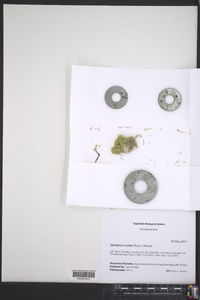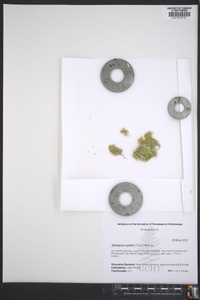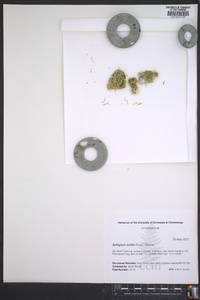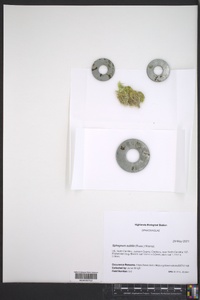
|
|
|
|
Family: Sphagnaceae
|
Plants small to moderate-sized, slender and stiff, capitulum ± rounded, rarely flat-topped or stellate; green to variegated red-green especially in new growth, capitulum, and antheridial branches, without metallic sheen when dry. Stems green to reddish, superficial cortical cells aporose. Stem leaves broad-triangular to triangular lingulate, 0.9-1.2 mm, apex acute to slightly rounded, border strongly broadened at base (more than 0.3 width); hyaline cells mostly 0-1-septate, S-shaped to rhomboid. Branches not 5-ranked. Branch fascicles with 2 spreading and 2 pendent branches (rarely 1). Branch leaves 0.9-1.2 mm, ovate-lanceolate, 0.9-1.2 mm, concave, straight, apex involute; hyaline cells on convex surface with numerous round to elliptic pores along the commissures (4-8), grading from small pores near apex to large pores at leaf base, concave surface with large round pores in proximal portions of leaf. Sexual condition dioicous. Spores 19-29 µm, finely papillose on proximal surface, more coarsely papillose on distal surface, conspicuous bifurcated Y-mark sculpture on distal surface; proximal laesura less than 0.5 spore radius. Capsules mature late summer to early fall. Hummocks, fens, mires; low to moderate elevations; N.B., Nfld. and Labr. (Nfld.), N.S., Ont., Que.; Conn., Ill., Ind., Maine, Md., Mass., Mich., Minn., N.H., N.J., N.Y., N.C., Ohio, Pa., Vt., Va., W.Va., Wis.; Europe. Sphagnum subtile forms small dense cushions and hummocks in damp coniferous forests and in the shaded portions of poor fens and ombrotrophic mires. Sporophytes are common in Sphagnum subtile. Reports that the species is monoicous may be unreliable because of confusion with closely related species (C. B. McQueen 1989). Previous reports of this species from the west coast of North America are uncertain as well as are specimens from the interior of the continent (R. E. Andrus 1979) due to taxonomic confusion with Sphagnum capillifolium and S. rubellum (McQueen). However, this species is conspicuously distinct in gametophyte and spore morphology as well as niche. In the northern part of its range where it overlaps ecologically with S. quinquefarium, the three spreading branches of the latter will distinguish it from S. subtile. It should be noted that contrary to the opinion of H. A. Crum (1997), S. subtile does not occur throughout the range of S. capillifolium but in North America is found over only a portion of the latter´s eastern range, while being absent completely from its western range. See also discussion under 71. S. capillifolium.
|








